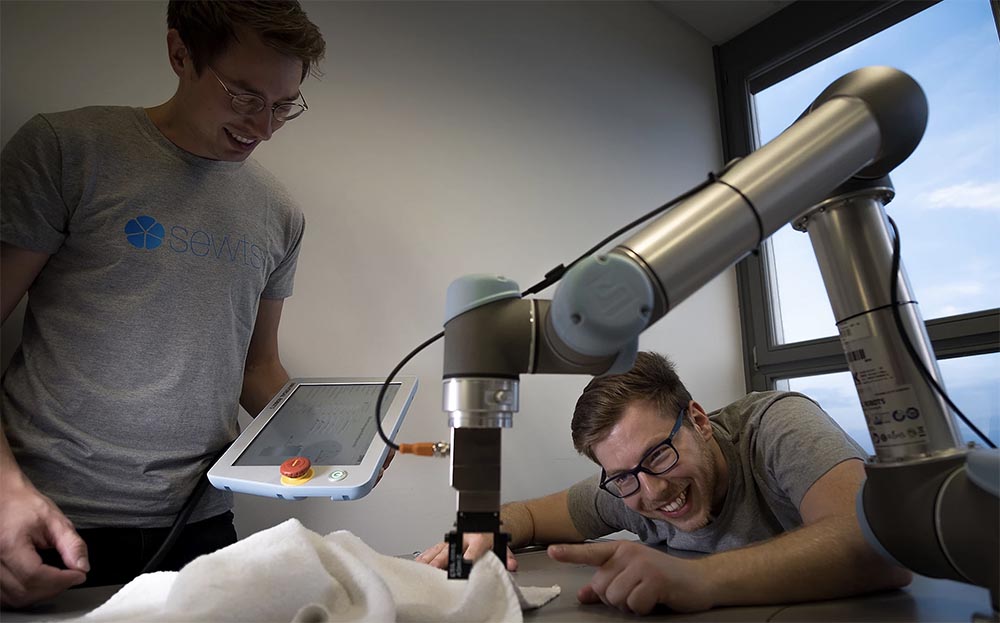Robotics and AI are changing the way businesses approach operational processes
What is the difference between the fourth industrial revolution from the previous ones? According to world experts, this is a merging of technologies, namely, blurring boundaries between the physical, digital, and biological industries. How does it manifest? We are increasingly celebrating new technological breakthroughs and revolutionary innovations in AI, blockchain, nano- and biotechnology, data science, and robotics, which affect all industries’ development and change the business environment.
The increase in demand for the adoption of AI technology has led businesses to seek ways to automate workflows. One of the innovative technologies that enterprises of all sizes can take advantage of is robotics, namely robotic process automation. Today, companies that keep up with technology choose to use robots to automate manual, repetitive, or rule-based human tasks.

According to experts and market research, in the next 5-7 years, the global RPA market will grow by 30%. Thus it is indispensable for businesses to invest in the current technology to quickly scale their operational processes.
We decided to take a closer look at robotics and RPA, using our interviewee’s example – 27-year-old Till Rickert, the Co-founder of the startup Sewts. Let’s find out how you can use robotics to improve your business, how to use robots in the textile industry, the secrets of launching a startup, and why leaving your comfort zone is crucial to attracting investors. Stay with us and learn a few valuable pieces of advice from our successful interviewee.
What is Sewts?
“Sewts was founded to disrupt the textile industry of today,” said the company’s website. Of course, it became curious to us to learn more about the company, and we asked our interviewee to tell us about the main idea of their solution and its foundation.
“We are developing the brain for the robots of tomorrow,” stated Till Rickert, the Co-founder of Sewts. “Business and industry still couldn’t automate many industrial processes because they are too complex. Our technology is an unprecedented solution to this issue.”
Till continued with a detailed explanation: “In particular, we used the latest advancements in machine learning and computer vision to develop an intelligent control software – robotic brain, to transform standard industrial tools into adaptive systems, which let us simplify complex manual labor into automated processes.”

Automated feeding of flat laundry onto industrial folding machines
Robotic solution for process automation
Moving on to the second question of our interview, we inquired about the startup’s background, what was the path of the Sewts and how it all started.
“Our journey started two years ago, when I and two friends of mine, who are now the Co-founders of Sewts, studied in the Technical University of Munich,” started Till from the very beginning. “We had been doing research in the field of handling technical textiles and flexible material, like carbon textiles.”
He continued: “The problem with textiles is that it’s tough to predict how they will behave if you touch them, for example. This is why many processes dealing with textiles are still done manually and not yet automated. This was the issue we wanted to solve,” Till explained to us what was the idea behind the development of their technology and continued, letting us know that it is somewhat more global than it might seem at first glance.
“We had been researching technical textile in the university, but what about everyday textile? I mean the clothes we wear,” Till got us thinking. “Mostly all of it is manufactured in Asia. But what if we could automate these processes and relocate the textile industry back to Europe?”
Disrupting the textile industry with robotics
Having discussed the main idea of their technology and the background of the company’s launch, we, of course, moved on to the topic of developing the technology itself. Till happily shared some details with us.
“After we had identified the problem and the solution, we started to design our prototype,” he began and moved on to the topic of the question. “We have studied the behavior of fiber-reinforced plastics, resulting in unique knowledge and techniques in the design and processing of technical textiles. We used this knowledge for non-technical textiles – apparel and linen, which allowed us to expand the scope of our technology,” stated our interviewee.
After explaining the prehistory, he came to the main point: “We developed a software technology, in particular, a robotic brain for advanced robotic solutions. Our technology’s cornerstones are the latest AI algorithms, computer vision (2D/3D vision systems), and textile simulations (textile behavior reproduction). We enable industrial robots with enough cognition to make the processes of textile handling more accessible and faster with no requirement for human intelligence,” shared Till with us the main features of their technology.
“Our system is smart enough to deal with all processes, which makes it a revolutionary or even disrupting milestone for the whole textile industry,” the Co-founder of the Sewts emphasized the uniqueness of their technology.
“Our system is smart enough to deal with all processes, which makes it a revolutionary or even disrupting milestone for the whole textile industry.”
Till Rickert
The prototype is crucial for attracting investors
One of the most frequent questions young entrepreneurs have, “How do I find funding to launch my business?” The thing is that there isn’t any magic, and nobody is waiting to throw money at you just because you have an exciting idea.
After reviewing the main aspects of a startup, we moved on to the second part of our interview and asked Till to tell us how they found the first investors and funding for their startup. He gladly shared with us.
“We’ve got public funding at first, basically from the German government. It was a scholarship from the EXIST Business Start-up Grant, and what you have to do to get it is to provide a detailed business plan,” started Till. “What also helped us very much in that stage, especially to build and finance the first prototype was the convertible loan by the Initiative for Industrial Innovators. They are a great help for early-stage startups,” noticed our interviewee.
“However, regarding the first funding we received from investors,” he decided to go straight to the heart of the matter and continued. “At the end of the last year, we closed our ‘pre seed’ round with around 500 000 euros. We already had a ready-made prototype in hardware and software, which included two robots and a camera. We took this prototype to present on different startup demo-days and expos’, where we could find potential investors.”
Does having a ready-made prototype increase your chances of getting funding and attracting investors? Till shared with us his opinion and gave a little advice based on his own experience.
“I think it’s crucial to have a prototype when you are looking for funding,” he stated. “If you are quite young, and it’s your first startup, and let’s say you don’t have enough credibility yet, it’s always better to have something to show to your potential clients, something they can touch or try with their own hands.”
Finishing the discussion on the issue of fundraising, Till recalled what this experience was for them: “Sure, it was a valuable experience for us, and it took us a lot of effort moving from one expo to another. But in the end, it worked for us greatly. And what’s important to notice, without a prototype, we wouldn’t get so far,” summed up our interviewee.
A good pitch = a great story
Summing up the funding aspect discussion, we could not help asking Till’s opinion on the good pitch to potential investors and if he can give some tips to our audience.
“In my opinion, if you want to make a good pitch, it’s more about the story than the content or images. Of course, you have to identify the problem and show your product’s value and the solution. But the most important is to make investors believe in your team,” shared the Co-founder of Sewts his thoughts.
Before you start discussing your business proposal with potential investors, you first of all need to get their attention. The goal of a good pitch is to attract investors’ interest enough to say, “That’s a great idea!”, nothing more, nothing less.
“if you want to make a good pitch, it’s more about the story than the content or images.”
Till Rickert
What is the main value of diversity in a startup team?
“Workforce diversity is a hot-button issue, but the tech world is still failing to keep pace.”
Unknown
Answering the secret of a good pitch, Till noticed that for investors, not only is the product itself essential but a reliable and purposeful startup’s team also. We asked Till to tell us about their team and why they can revolutionize the textile industry with robotics.
“We are about 16 people right now,” stated the Co-founder of Sewts. “The bigger part of our team are software developers, who develop the back-end for the technology, AI, and computer vision. We also have a small prototype department – three experts who are involved in hardware engineering. I have to say, we have a great team because we have interdisciplinary experts, which enables us to design and develop prototypes very fast,” our interviewee emphasized the importance of diversity for the startup’s success.
How companies like Apple, Google, Microsoft, and Facebook achieved success? They understand the actual value of having an outstanding and diverse team.
“We have interdisciplinary experts, which enables us to design and develop prototypes very fast.”
Till Rickert
Geography of clients as the sign of startup’s success
Why only 10% of startups become successful? They can create an innovative and flexible business model and respond to changing customer needs on time.
Continuing our interview, we asked the Co-founder of Sewts about their clients and what business model they choose for their startup.
“It’s 100% B2B,” stated Till and told us who the company’s product is aimed for. “Our main clients are industrial automation companies who have experience building reliable automation systems but need help with the software part, in particular AI and cognition systems.”
And what about the geography of clients? Till noted that for young startups, it is certainly easier to start with local clients. He also shared that their client’s geography is no longer limited to Germany, which is a significant indicator of their startup and technology’s growth and success.
Contracts, partnerships, potential clients and other measures of success
After discussing the business model and customer aspects, Till’s response clarified that the startup’s success depends on many factors. Of course, we asked him how he measures Sewts achievements, what wins they can boast of today. Our interviewee gave us a comprehensive answer.
“Right now, we are signing partnership contracts for development and focus on signing pilot customers, as well,” stated Till and continued with the following. “Our current success measures are signed contracts and quantity of leads we can turn into customers.”
To get traction, solve the unsolved problem
We decided not to dwell on metrics and current successes but to raise the topic of the global impact of the Sewts product on business and industry in general. Let’s find out what Till told us when we asked him what he thinks he admires most about their startup and the development of their technology.
“The most exciting thing is that we are disrupting the industry because we are solving problems that have been there for many years,” our interviewee began with the critical point.
He also emphasized the importance of product value for the market and consumer’s needs. “We are getting more and more attention from the market – clients who approach us and ask us if we have a technology and system to automate their processes, which confirms the value of our product and what we develop. And I think that is what makes the whole thing exciting and motivates us to keep moving in this direction.”
Some of the most successful startups today – the ones that disrupt the industry and create the value that customers are looking for in the new technological era.
Growth plans
Moving on from the main aspects of startup development to broader factors, we asked Till about their growth plans. Although his answer was short, it showed us that Sewts already have a plan and strategy for growth and development.
“We are planning to add more experts to our team and scale up to 50 people. And of course, expand in more countries with more clients in our list.” No doubt, growth is critical to the long-term survival of a startup.
Leave your comfort zone to achieve success
All stories about attracting and finding first customers are unique in their way and contain valuable advice built on their own experience. Till’s answer to how they found their first customers surprised us, as their approach was different from other startups.
“We went out to look for the application and clients even before we launched the company. We did it actually by cold calling and online research. In this way, we have found the first few potential customers,” shared our interviewee with us.
He also highlighted the following important point: “When you are looking for your first customer, you may feel a little bit inexperienced, but you have to leave your comfort zone to achieve success. This strategy worked well for us.”
A little bit of discomfort goes a long way in terms of self-development. It’s a great way of improving your skills, creativity, and experience in the long run.
“You have to leave your comfort zone to achieve success.”
Till Rickert
What decisions can become a threat to a startup?
What are the most common risks and challenges young startups face? According to experts, 20% of businesses fail within the first two years due to poor financial decisions. Is there a way to avoid this?
Of course, we asked our interviewee what he thinks about threats and financial risks during startup development.
“When you are a startup, you mostly always have a limited amount of money. One of the biggest threats is to make the wrong decision on how to spend that money,” Till admitted and shared his example. “In our case, robots are costly, and before investing 20-30 thousand euros, we have to think at least twice.”
Where to start your startup or why it’s crucial to learn from experienced mentors?
What differentiates successful startups from those that fail? It is the vision and willingness to take steps required to turn their idea into a viable business. We asked our interviewee to share what helped him get off the ground and turn his idea into a successful startup.
“For us, it was beneficial to ask for advice from the experts in our university, in particular TUM Start-up Advising team and UnternehmerTUM,” he said and emphasized the importance of getting a response from experienced mentors and entrepreneurs. “If you are a young startupper, you should look for some acceleration programs or entrepreneurship centers and start with pitching your idea to them. They might ask you the questions you don’t like, but it’s good because they will challenge you.”
“Great entrepreneurs are made, not born.”
Unknown
Inspiration from the greatest minds
Motivation is the driving force for young startups. Where to get it? One of the personal questions that we always ask our interviewees, startup’s co-founders, and CEOs: “If there are famous executives who inspire them?”
“Elon Musk is a very inspiring person for me because he always makes things done,” shared Till with us. “He is one of the pioneers who motivates me the most because he does things that seem quite impossible for humanity. I think it goes from his mentality.”
Advice for young entrepreneurs
The last point of our interview and fascinating conversation with Till was a request to advise aspiring entrepreneurs who are at the start of their journey.
“I am a spontaneous person, who doesn’t plan something,” he admitted and further explained his confession. “In the scope of that, what I would advise to myself is to think twice about what to study. I studied mechanical engineering, but in the end, I am doing software development in Sewts,” said Till.
“However, everything worked great for me, but what I wanted to say is it’s still better to have a plan for the future,” the Co-founder of Sewts shared with us his valuable and essential life observation.
“It’s still better to have a plan for the future.”
Till Rickert
To end with…
Without a doubt, robotic process automation is one of the most innovative technologies in the current era, which will allow any business to optimize routine and repetitive tasks, and as a result, reduce costs, increase productivity and income.
We are now living through the fourth industrial revolution, powered by a fusion of technologies that are changing business and industry beyond recognition and create an incredible scale environment for opportunity and implementation of innovative tools. One such example is the startup Sewts and the story of its Сo-founder Till Rickert.
The world is preparing for a new digital change, and the greater adoption of robotics and robotics process automation will be a boon for businesses in every industry.




